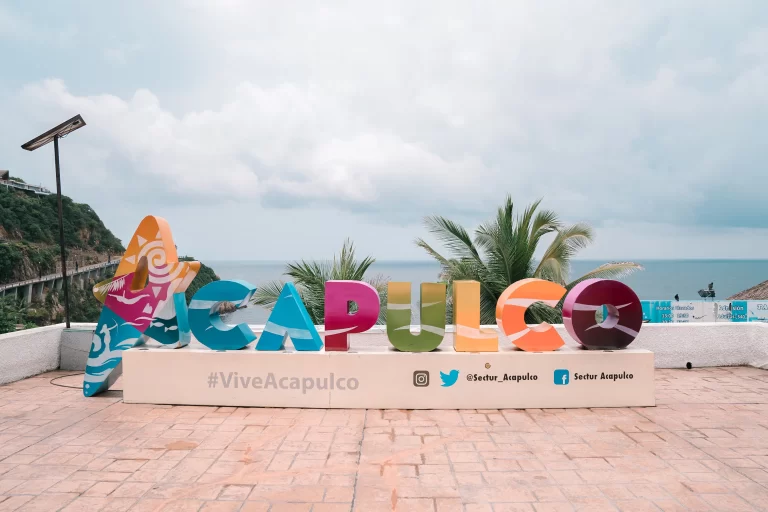Places you must Visit in Japan – Kyoto, Osaka, Nara
京都、大阪、奈良
Kyoto
Kinkaku Temple
Kinkaku-ji is a temple of the Shokoku-ji branch of the Rinzai sect located in Kita Ward, Kyoto City. The appearance of that golden building towering over the pond is a familiar sight on television. Its official name is Rokuonji, commonly called Kinkakuji because the reliquary hall, Kinkaku, is so famous.
The second and third layers are covered with pure gold leaf, and a golden phoenix shines on the roof. It is no wonder that the garden and architecture around Kinkaku are said to have been created in the image of the Pure Land. Many people visit one of Kyoto’s leading tourist attractions every year to see it in person.
The reliquary hall of Kinkaku-ji Temple is often referred to simply as a gold-leaf building. Still, in fact, the style differs for each layer. The first floor is shinden-zukuri, the second is samurai-zukuri, and the third is Zen-Buddhist butsuden-zukuri.
Another highlight of Kinkakuji is Sekkatei, a small tea room built for Emperor Gomizunoo. Sukiya-zukuri means a house built according to one’s taste” and features Nanden alcove pillars” made of Nandina wood and a triangular “Hagi-no-hagi” with an Oshukubai tree in the center. Various ideas, such as “different shelves,” are elaborated. Let’s peek into the tea room, which is only 3 tatami mats in size, and imagine what a tea ceremony would have looked like in those days.
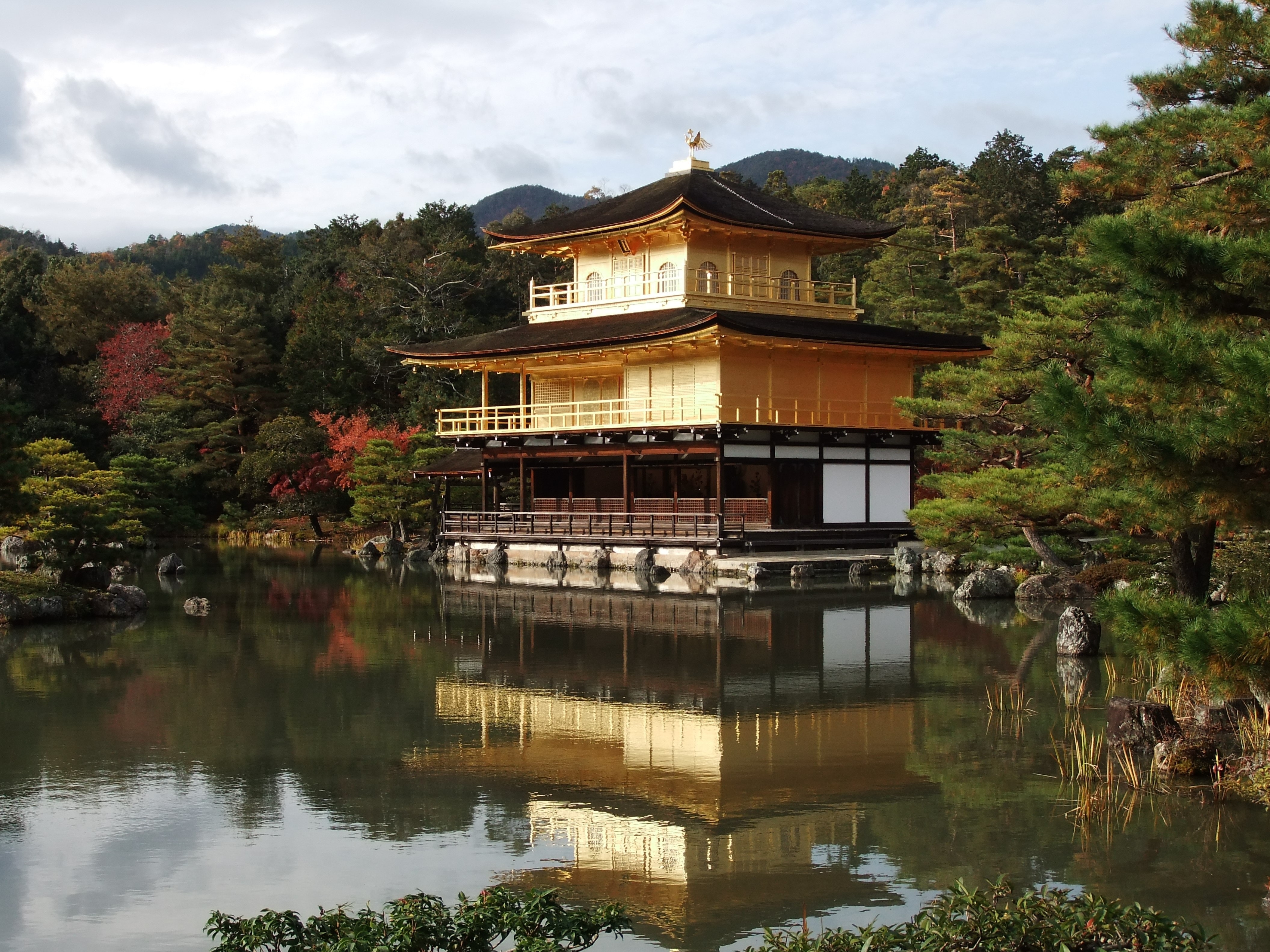
By train. Take the Karasuma Line from JR Kyoto station to Kita-Oji station (approx. 14 minutes). Walk 2 minutes from Kita-Oji station to Kitaoji Bus Terminal, where a number of Kyoto City Buses (#101, 102, 204, or 205) will take you to Kinkakuji-michi bus stop
Ginkaku Temple
Ginkakuji began as a villa built by Yoshimasa Ashikaga, the eighth shogun of the Muromachi Shogunate, following his grandfather, Yoshimitsu Ashikaga. After Yoshimasa’s death, it became a Zen sect of the Shokoku-ji branch of the Rinzai sect and was named Jisho-ji. Ginkaku-ji Temple, compared to Kinkaku-ji Temple for its elegant and glamorous beauty, is characterized by the simple beauty of “wabi-sabi” that strongly inherited the influence of Zen Buddhism. Unlike Kinkakuji, where the reliquary hall is covered with gold leaf, Kannonden, commonly known as “Ginkaku,” does not use silver. Kannonden and Togudo, Japan’s oldest Shoin-zukuri building, are designated national treasures. There are many highlights, such as the Ginshadan, which expresses waves with white sand, the conical Kogetsudai, and the pond garden centered around Kinkyochi. It is a perfect beauty that you will stay energized even if you visit often. Buses are convenient from JR Kyoto Station.
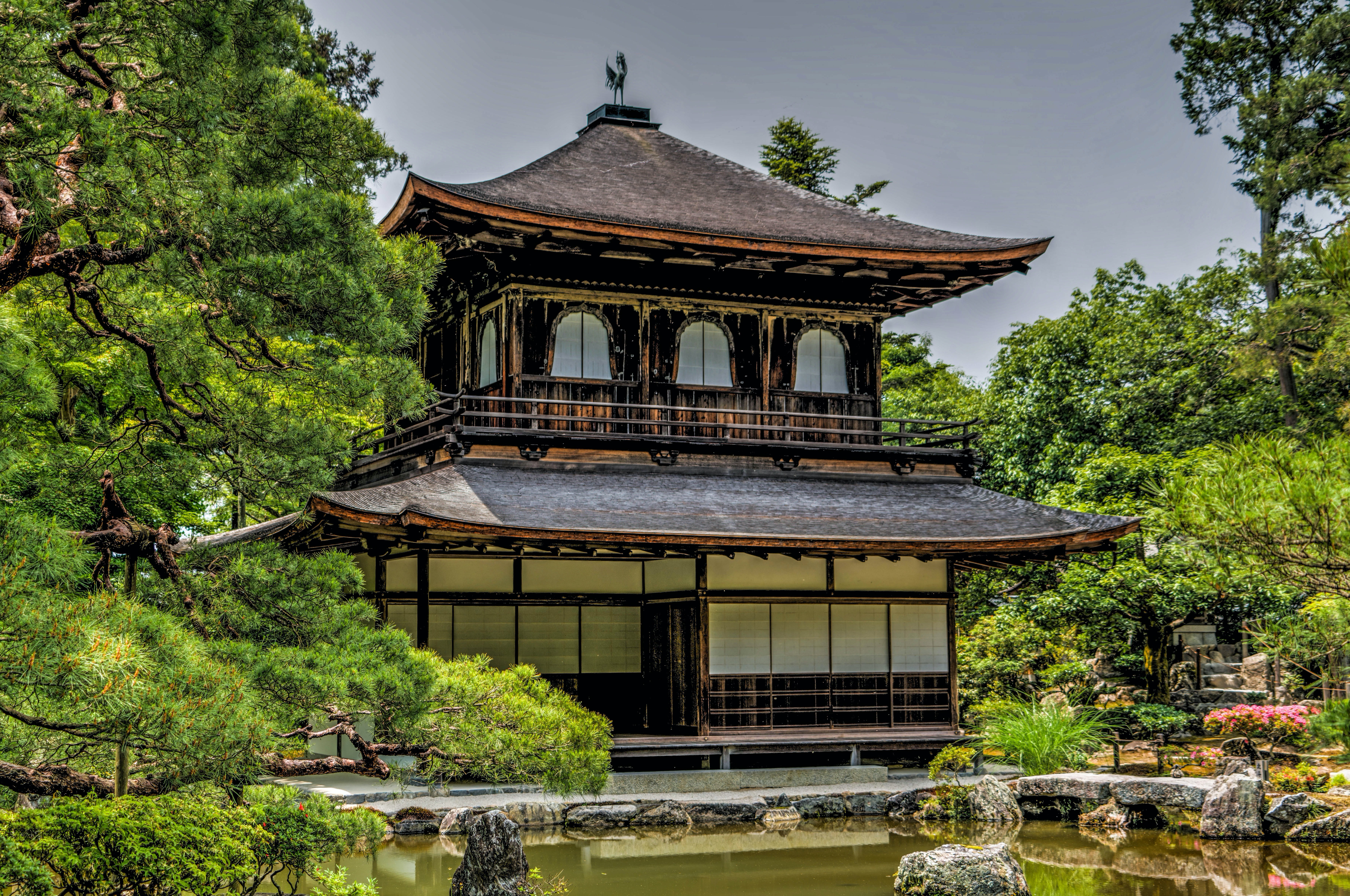
Ginkakuji can be accessed by direct bus number 5, 17 or 100 from Kyoto Station in about 35-40 minutes and for 230 yen one way. Alternatively, you can reach Ginkakuji by foot along the Philosopher’s Path from Nanzenji in about 30-45 minutes.
Fushimi Inari Daisha Shrine
The head temple of Inari shrines is said to have about 30,000 shrines all over Japan. The Senbon Torii, with its red torii gates, is a world-famous photo spot and attracts tourists worldwide. Fushimi Inari Taisha, lit up at night, can be visited at any time of the day. Its long history dates back to 711 in the Nara period. It has long been worshiped by commoners who seek blessings such as a bountiful harvest, prosperous business, family safety, and fulfillment of various wishes. In Fushimi Inari Taisha, the entire vast Inari mountain is the object of worship. It starts from the Okusha Hohaisho, located after passing through the Senbon Torii. It takes about 2 hours to go around a distance of about 4 kilometers. You can go on a pilgrimage with the “Oyama Meguri.”
I’m looking forward to visiting many power spots, such as.
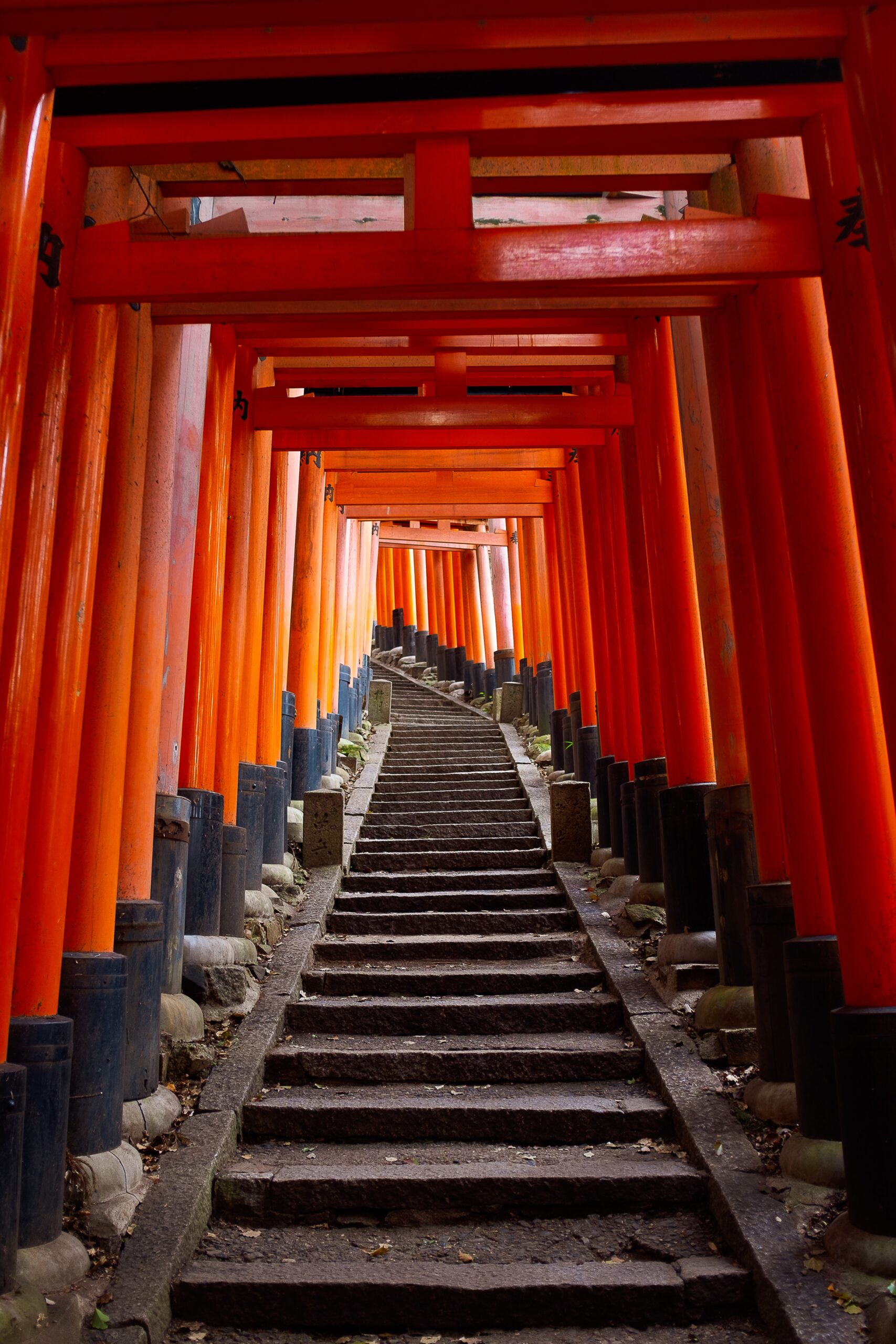

Take the JR Nara Line to Inari Station. The shrine is located in front of the Inari Station. Alternatively, take the Keihan Line to Fushimi Inari Station. It’s about a 7-minute walk from there
Gion
Gion is the standard sightseeing course in Kyoto. If you visit Kyoto, you want to experience the atmosphere of the ancient capital where maiko walks the cobblestone streets. To access Gion, taking a bus from Kyoto Station is convenient. Gion developed as a temple town centered on the Yasaka Shrine. Still, it is also an area with many historic temples and shrines, such as Kodaiji, Kenninji, Chionin, Kiyomizudera, Shorenin, Hokanji, etc. Shirakawa Minami-dori Street, Hanamikoji Street, and Ishibekoji Street, lined with Kyomachiya houses, are paved with stones, and the atmosphere is significantly enhanced at night. In addition, there are many other attractions such as Yasui Konpiragu Shrine, which is known for severing relationships; Maruyama Park, which is famous for weeping cherry blossoms; Sanneizaka Preservation District for Groups of Traditional Buildings, which leads from Kiyomizu Temple to Kodaiji Temple, and Ryozen Kannon. Make sure to take plenty of time to walk around.
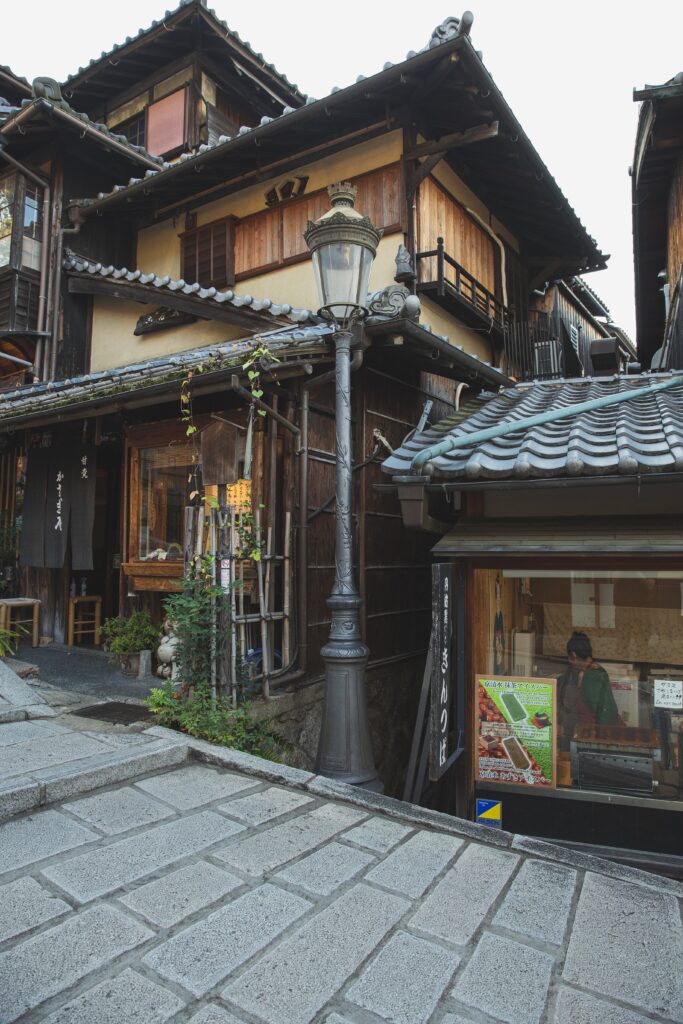
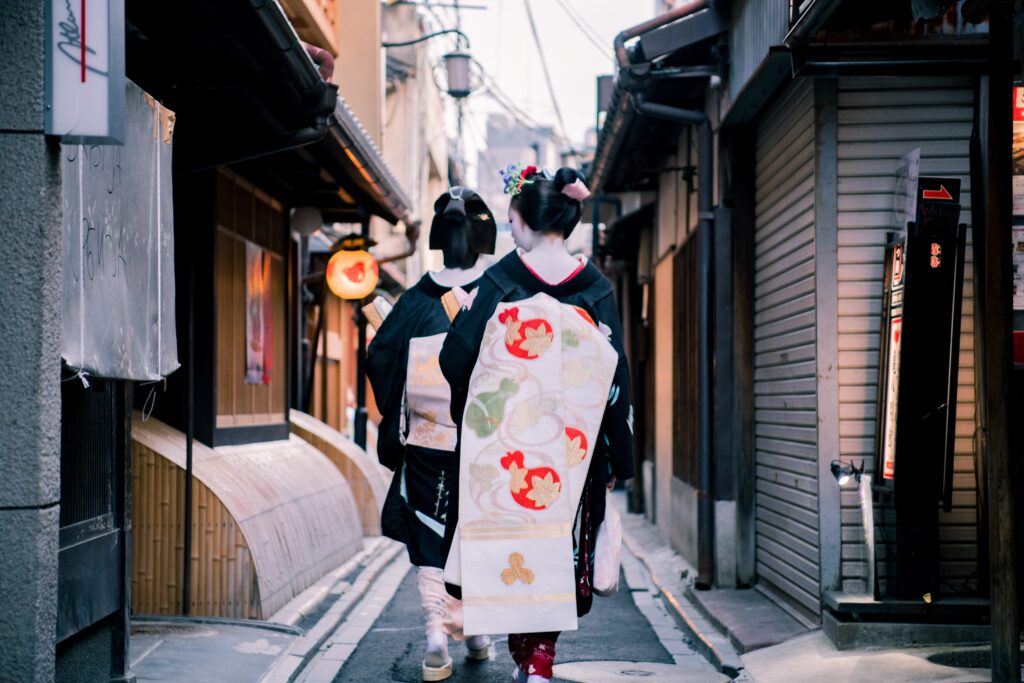
Arashiyama
The bamboo grove path in Arashiyama in the western part of Kyoto City is a popular tourist attraction well-known on TV for its beautiful scenery of continuous bamboo groves. It is a 400-meter road from Nonomiya Shrine through the north gate of Tenryu-ji Temple to Okochi Sanso. It is flanked by manicured bamboo groves on both sides.
The path of the bamboo grove, where the sunlight filtering through the trees is beautiful, has an exquisite atmosphere, as it is said that it was a villa area for aristocrats in the Heian period. In addition, many attractions, such as the Togetsukyo Bridge, are nearby, and many tourists visit throughout the year.
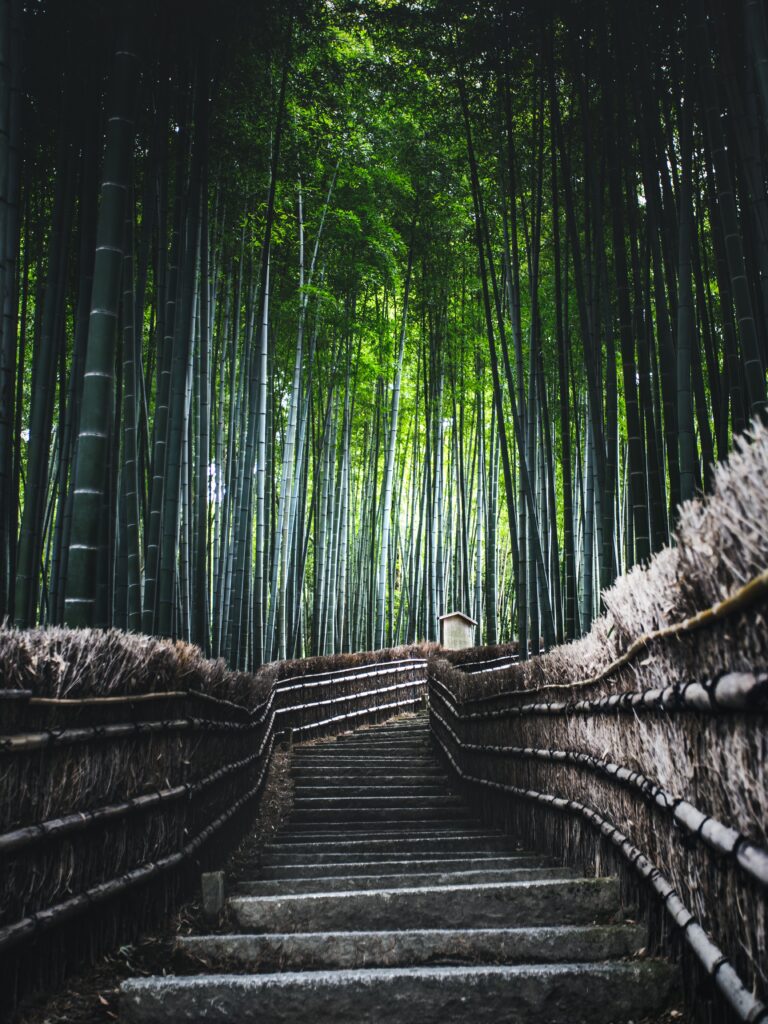
The fastest access from Kyoto Station to Arashiyama is provided by the JR Sagano Line (also known as JR Sanin Line). The one-way ride to Saga-Arashiyama Station takes 15 minutes and costs 240 yen. From the station, it is a 5-10 minute walk to central Arashiyama.
Arashiyama Monkey Park Iwatayama
A spot where you can play with wild Japanese macaques on a hill overlooking the city of Kyoto. Located in Arashiyama, Kyoto, Arashiyama has many quiet but famous temples, such as Nison-in Temple
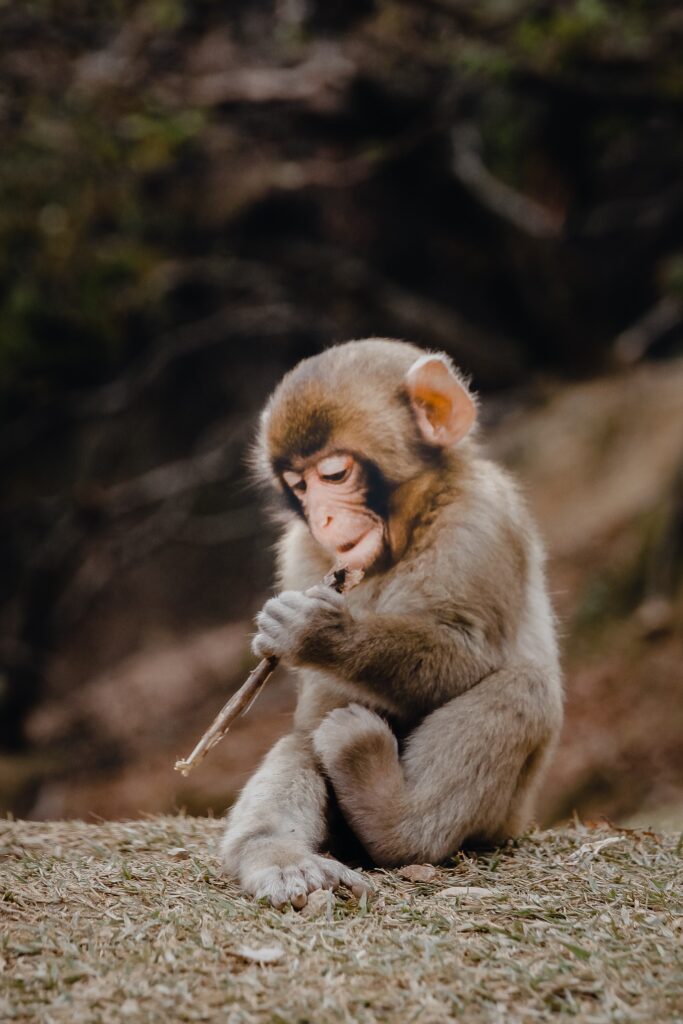
Take a 15-minute train from JR Kyoto Station to JR Saga-Arashiyama Station (¥240 one way). Walk down the scenic streets over the bridge of the Oi River to get to Monkey Park, which is on the opposite side of the river. Stroll through Arashiyama Koen Park along the way.
Place to Eat
OSaka
Osaka Castle
Built in 1583 by Toyotomi Hideyoshi to unify Japan, Osaka Castle is a landmark of Osaka. With a total area of 105.6 hectares, many historical remains have been designated as nationally significant cultural properties, such as the castle tower of Osaka Castle, the Kinmeisui well house, Kinzo, Enshozo, and Otemon. The original castle tower was destroyed by fire during the Summer Siege of Osaka. It was later rebuilt during the Tokugawa period. Still, it was damaged by lightning, and the current castle tower is the third. The castle’s interior is a museum, displaying materials related to the Warring States period and the history of Osaka Castle. The observatory on the 8th floor is a popular tourist spot where you can see the cityscape of Osaka from a height of 50 meters above the ground. It can be accessed by multiple lines, such as JR Osakajokoen Station, subway, and Keihan Railway.

From Osaka Station, the easiest way to get to Osaka Castle is to take the Osaka Loop Line to Osakajokoen Station on the park’s northeast side. From there, it is an 18-minute walk from the park grounds to the castle.
Universal Studio Japan
At Universal Studios Japan, you can enjoy Hollywood-themed rides and shows featuring popular characters. Immerse yourself in the world of the movies at Jurassic Park, Waterworld, and the New York Area, or play to your heart’s content at Super Nintendo World™ and Minion Park, plus popular characters. There are also goods and food and various ways to enjoy it.
Universal Studios Japan has a lot of attractions. Still, if you purchase an Express Pass, you can enter the area you want to join without fail. You can also shorten the waiting time for popular attractions so you can go around efficiently.
In addition to the five areas mentioned earlier, Universal Studios Japan has 10 regions, including “Universal Wonderland” and “Hollywood Area.” Every site is full of movie scenes and famous characters, and walking around is fun. There are also many rides and attractions with different themes in each area, so it’s a good idea to narrow your target on the website beforehand.
Also, at Universal Studios Japan, there are a lot of limited-time events and shows, such as “One Piece Premier Summer”. We recommend that you check the schedule and go on the same date.
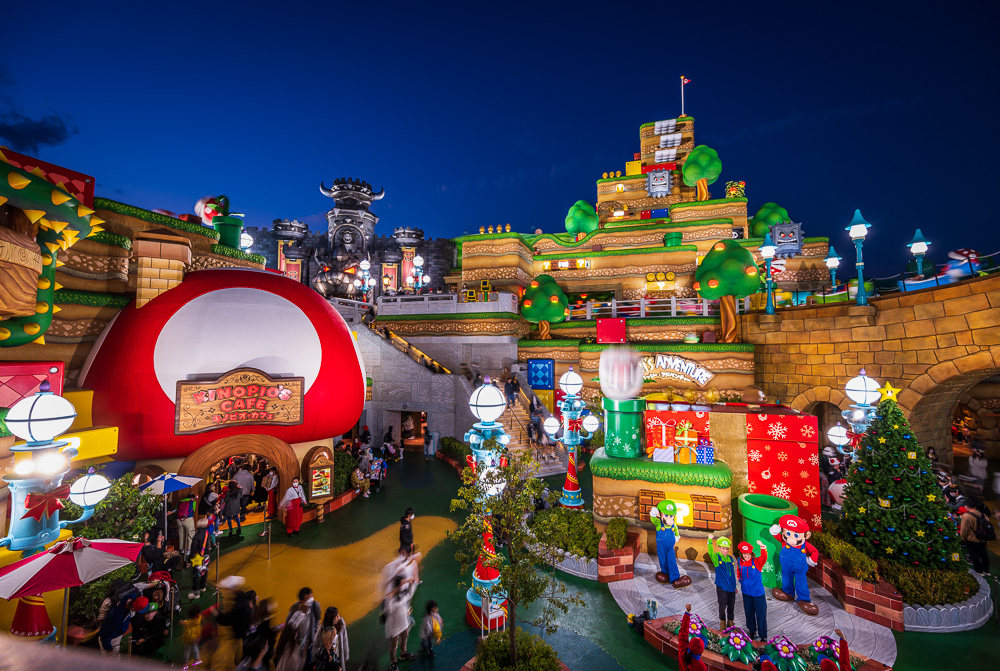
https://www.usj.co.jp/web/en/us
While in Osaka, from Osaka Station City, take the Osaka loop line, also known as the Osaka Kanjo line, to Nishikujo Station. Then, take the Sakurajima line (or Yumesaki line) to Universal-City Station. Once in there, Universal Studios Japan is under 5 minutes.
Kaiyukan Aquarium
At Kaiyukan, you can meet various creatures of the Pacific Rim in 14 exhibition tanks, including the vast “Pacific Ocean” tank. Based on the concept that “the earth and all living creatures living on it are one living organism that interacts with each other,” these tanks are arranged to faithfully reproduce the geographic relationship of the Pacific Rim. See river basin fish, penguins from Antarctica, and white-sided dolphins from the Tasman Sea.
Kaiyukan is located in Tempozan Harbor Village, a complex amusement facility facing Osaka Bay, and there are many attractions nearby, such as the Tempozan Giant Ferris Wheel. A 5-minute walk from Osakako Station on the Chuo Subway Line, this is a popular spot in Osaka where adults and children alike can have fun all day long.

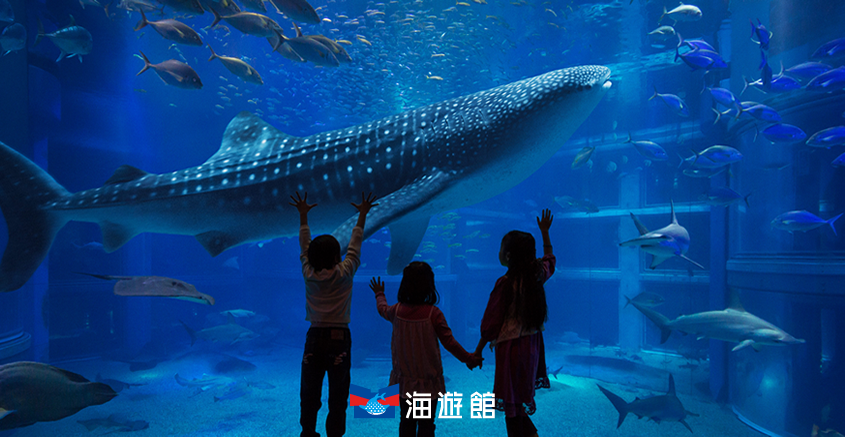
https://www.kaiyukan.com/language/eng/
From JR Osaka Station , take the JR Osaka Loop Line to Bentencho Station. Transfer to the Chuo Subway Line, and ride two stops to Osakako Station. From there, follow the signs to the aquarium, which is a five-minute walk from the station.
Tsutenkaku
Tsutenkaku, towering over Shinsekai, an entertainment district in Naniwa Ward, symbolizes the energetic downtown Osaka. At 103 meters high, the observatory at Tsutenkaku offers a panoramic view of Osaka. Speaking of Tsutenkaku, you can’t miss “Billiken-san.” The God of Happiness is enshrined in the Golden Observatory on the 5th floor, and it is said that rubbing the soles of the feet will bring good luck. On the 4th floor, there is a “light observatory” that lights up with mirror balls and flashy lights at night, and “Tenbo Paradise” at the top of Tsutenkaku can be rented out for couples to propose. It is a unique space that sometimes.
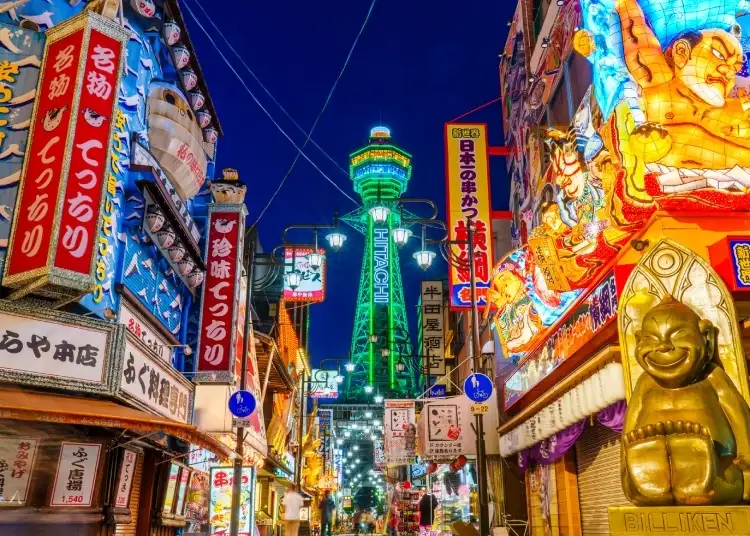
To get to Tsutenkaku Tower, located in Shinsekai, from Osaka Station, take the JR Loop Line to Shin-Imamiya Station. It’s a 6-minute walk from there. If traveling by the Midosuji Subway Line, get off at Dobutsuen-mae Station. It’s a 6-minute walk from there.
Doutonbori
Dotonbori is an entertainment district where you can enjoy Osaka gourmets such as takoyaki, okonomiyaki, kushikatsu, and crab. The river’s name comes from Doton Yasui, who started waterway construction in 1612.
Walking along the riverside promenade “Tombori River Walk” is recommended at night, where neon signs, such as the Glico signboard, symbolize Osaka.
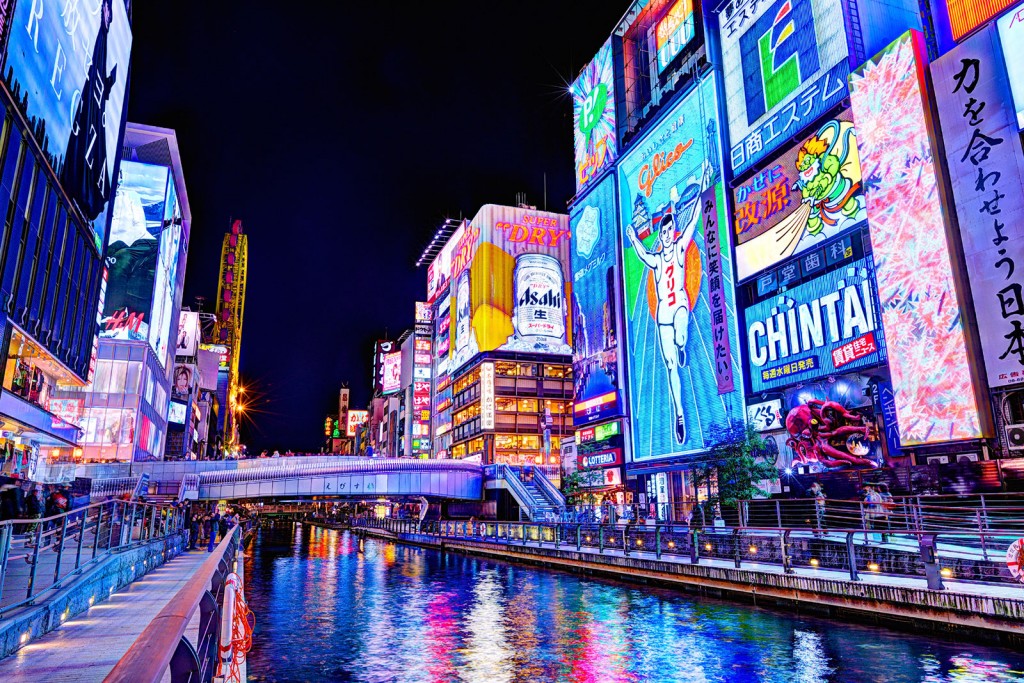
Umeda Sky Building
The Kuchu Teien Observatory is a 360-degree rooftop open-air observatory that connects the east and west towers of the skyscraper Umeda Sky Building. It features a structure resembling a diamond ring floating in the sky.
From 173 meters above the ground, you can see the city of Osaka and even Awaji Island. The night view spreading over the entire area below is also popular.
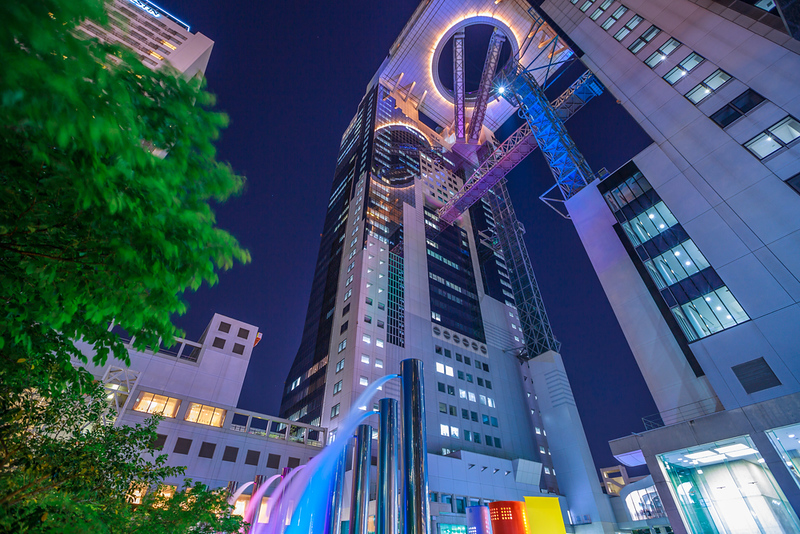
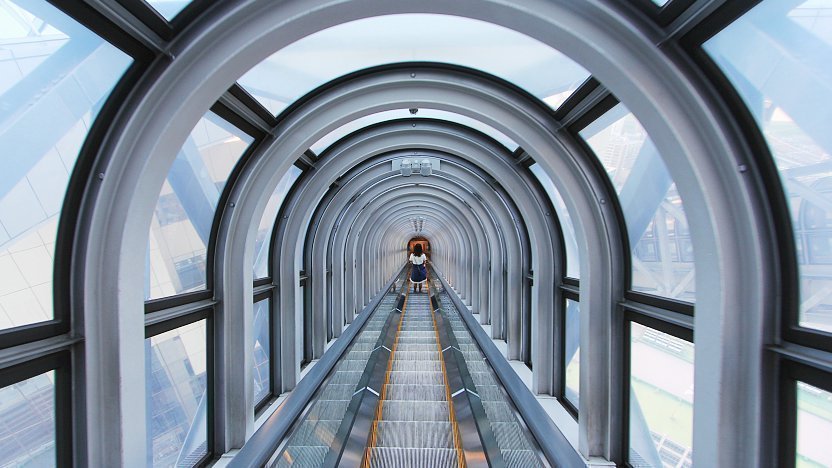
The Umeda Sky Building is located in the Kita district of Osaka, near both the Osaka Station City (JR) and Umeda Station (Osaka subway). In fact, it is a mere ten-minute walk from Osaka Station City through an underground passage under the train tracks.
Recommended Eat

Nara
Nara was the center of ancient Japan and was the ancient capital of Heijo-kyo until the Nara period more than 1,300 years ago. After that, the capital was moved to Heian-Kyo, Kyoto, but for that reason, the remnants of the mythology and the introduction of Buddhism, which can be said to be ancient Japan, remain.
Nara Prefecture has the most significant national treasures and world heritage sites among the 47 prefectures. It is a treasure trove of cultural heritage, such as burial mounds, ancient shrines and temples, and the ruins of the magnificent capital. A significant feature is that many influential buildings and Buddhist statues are more dynamic and appeal to the soul, different from the refined Heiankyo culture.
As the land is surrounded by mountains with a basin in the center, each region’s characteristics are also varied. Starting with the area centered on Nara City in the northern part of the prefecture, where you can encounter a considerable amount of cultural heritage wherever you go, the Ikaruga and Asuka areas in the western region, where the culture of older times remains, and the mountainous areas on the eastern side, where the mythical world of Uda and Mt. There is no shortage of places to visit, such as the area around Nobe, and the vast Yoshino area in the south where the Southern Court was once located. Let’s look at what kind of sightseeing spots there are by size.
Todaiji Temple
The most famous one in Nara, registered as a World Heritage Site, is the Great Buddha of Todaiji Temple. The giant 15m-tall Vairocana Buddha is a must-see tourist spot for Nara, along with the Daibutsuden, where the Great Buddha fits completely.
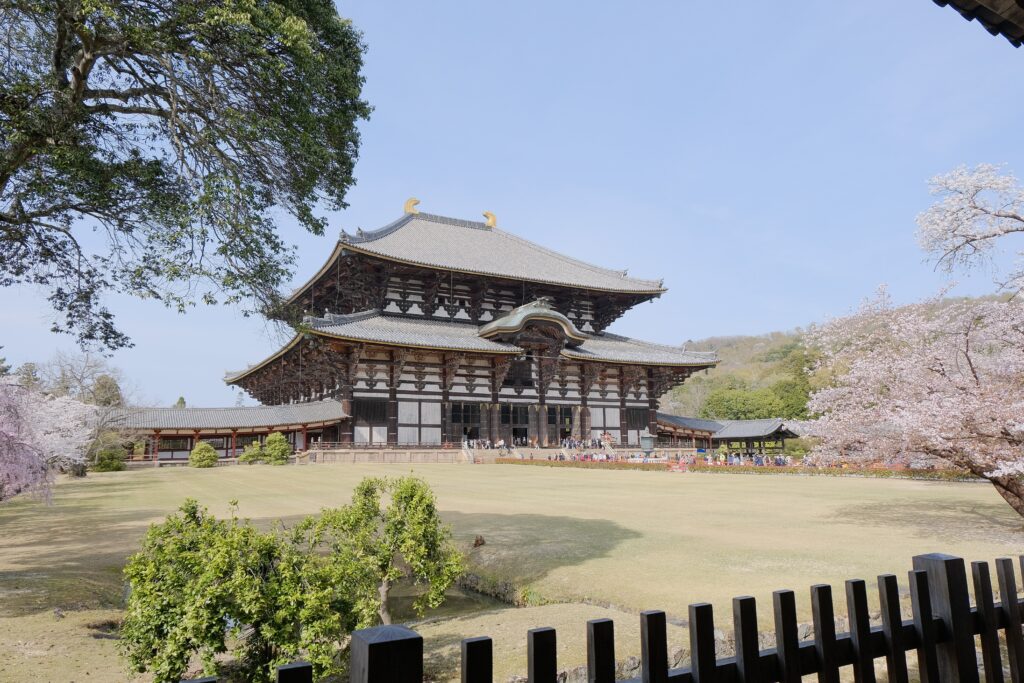
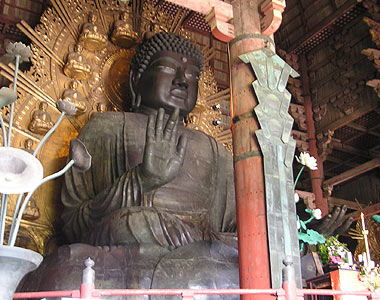
Todaiji is located in the northern part of Nara Park. It is about a 30-minute walk from Kintetsu Nara Station or about a 45-minute walk from JR Nara Station. It can also be reached by bus from either station. Get off at Todaiji Daibutsuden, from where it is a 5-10 minute walk to Todaiji’s main building.
Nara Park
A vast urban park on the east side of Nara City, with a total area of about 502ha, about 4km east-west, about 2km north-south. The park includes the precincts of Kasuga Taisha, Kofukuji, and Todaiji, as well as the virgin forest of Kasuga Okuyama, the sacred area of Kasuga Taisha. Although it is a park, it has become a central sightseeing spot in Nara, where national treasures and world heritage sites are scattered.
Most of the area is filled with lush green lawns and 1,000-year-old pine trees, and about 1,300 wild deer, the park’s mascot and a natural monument live here. There is a path that Omiya people used to walk on, which is mentioned in the collection of poems “Manyoshu.” If you turn your eyes away, you can see a range of mountains, such as Mt. Wakakusa, Mt. Kasuga, and Mt. Takamado.


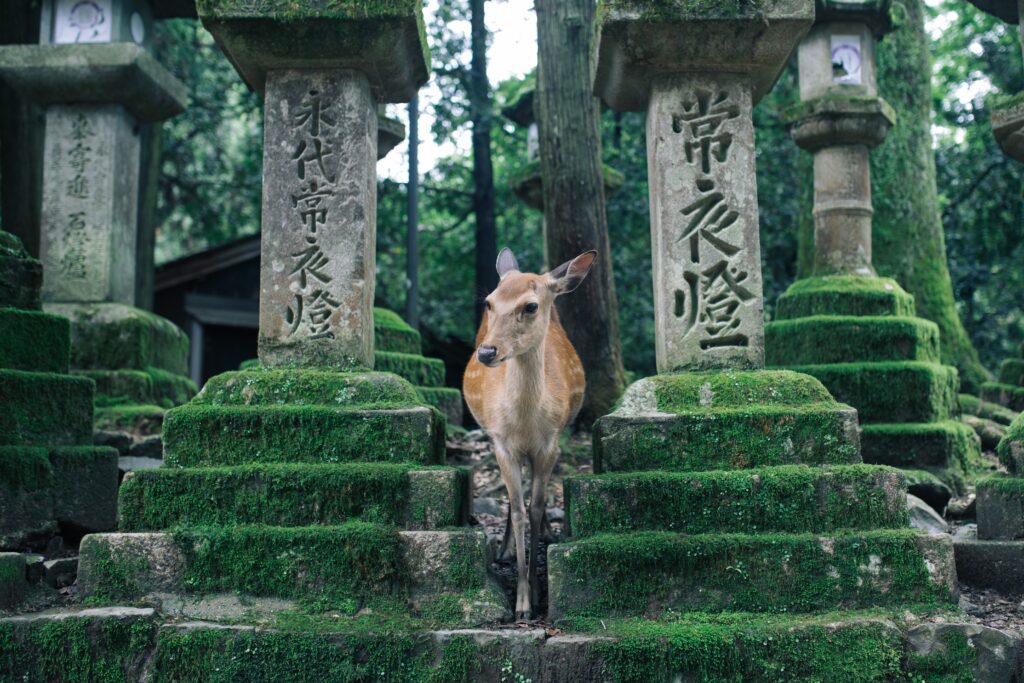
The easiest way to get to Nara Park from Kintetsu Nara Station is on foot. The park is just 6 minutes from the station. When you exit the station, turn right on the road outside and walk in an eastern direction.
Kasuga Taisha Shrine
The Kasuga Taisha National Treasure Hall on the grounds houses and displays about 3,000 treasures, including 352 national treasures and 971 important cultural properties. Kasuga Taisha Shinen Manyo Botanical Garden also cultivates about 300 flower species in the Manyoshu. Manyo-uta (Japanese poetry) related to the festival is added to the event, creating a sense of interest. The Kasuga Primeval Forest that leads to Mt. Kasuga in the background offers a glimpse of its untouched and protected prehistoric appearance.
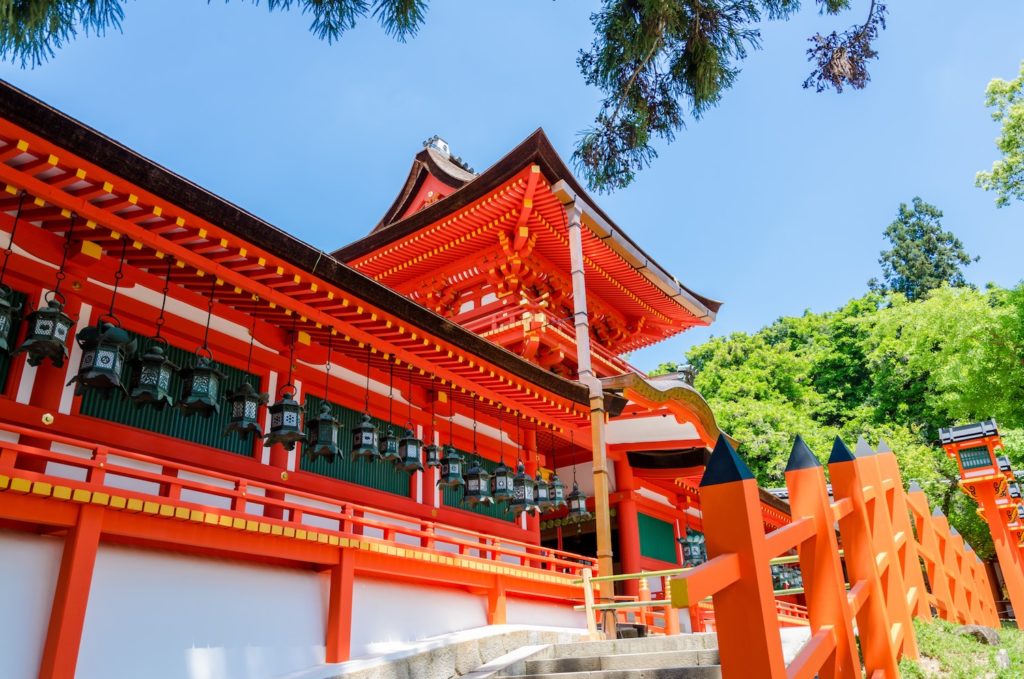

Kasuga Taisha is easily accessed by bus or taxi from Kintetsu or JR Nara stations. Frequent bus services run from both stations to Kasuga Taisha Honden bus stop. You can also walk there approximately 30 minutes from Kintetsu Nara Station and 45 minutes from JR Nara Station.
Nakasendo (Samurai Trail Hiking) Gifu
The Nakasendō, also called the Kisokaidō, was one of the five routes of the Edo period and one of the two that connected Edo to Kyoto in Japan. The total length is approximately 9 km (required time: around 3 hours), connecting Magome-juku to Tsumago-juku (Magome-juku → Magome Pass → Tsumago-juku), and you can hike while enjoying the beautiful scenery of the seasons, such as the Kiso mountains, valleys, and waterfalls.
https://kiso-magome.com/hiking



